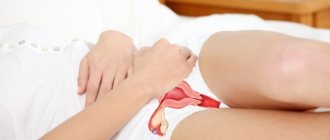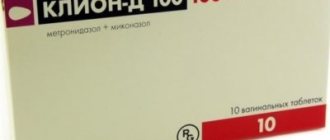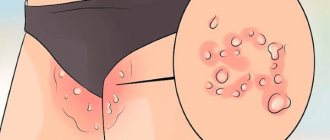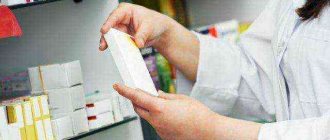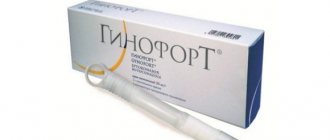Letrozole is used to stimulate ovulation in cases of endocrine infertility. The active ingredient of the drug is aimed at the development and growth of follicles, from which viable eggs ready for fertilization are released in the middle of the cycle. We will find out in this article what medications it can be combined with and whether there are strong side effects.
Letrozole for ovulation stimulation
When prescribing a drug in order to increase the likelihood of a new life, most doctors recommend a dosage of 2.5 mg per day (1 tablet). You need to start taking it on the 3rd day after the start of menstruation and take it for 5 days. In studies of this dosage regimen, 27% of pregnancy cases were recorded among women who were previously suspected of infertility. Other doctors, using Letrozole to stimulate ovulation, prescribe 5 mg of the drug per day (2 tablets), noting an increased number of positive results. Studying this dosage regimen, 37.6% of positive pregnancies were recorded among the total number of patients.
With the first dose, ovulation was recorded in 84.4% of women, and with an increased dose in 67.5%. It was noted that taking the drug according to the first method is more favorable for ovulation, however, with an increased dose, pregnancy occurred in a larger number of girls.
general characteristics
Letrozole is an aromatase inhibitor drug that helps reduce estrogen secretion in postmenopausal women. Aromatase acts on androstenedione and testosterone secreted by the adrenal glands. Due to this, the adrenal hormones are transformed into estrone and estradiol (female sex hormones). Suppression of the action of aromatase helps to stop the transformation processes and reduce estrogen levels.
- Compound. Contents of one tablet:
- letrozole;
- magnesium stearate;
- pregelatinized corn starch;
- microcrystalline cellulose;
- colloidal silicon dioxide;
- sodium carboxymethyl starch;
- lactose monohydrate.
- Description of the drug:
- tablets have a round, biconvex shape;
- The film shell of the letrozole tablet is yellow, and the core in cross section is white, but depending on the manufacturer, the color may have a yellowish tint.
- Release form. The weight of one tablet is 2.5 mg.
One pack contains 30 tablets (10 tablets in one blister). Attention! Other forms of release of the drug are possible, depending on the manufacturer. - Price. The price of letrozole varies from 2200 to 2500 rubles.
- Indications for use. Recommendations for use:
- recommended for the initial stages of breast cancer (BC) of estrogen-dependent types during the postmenopausal period as an auxiliary therapy, as well as for the early stages of breast cancer after the end of the first stage of adjuvant therapy with tamoxifen as its continuation;
- for hormone-dependent forms of breast cancer after menopause as first-line therapy;
- in advanced stages of breast cancer after anti-estrogenic therapy in postmenopause as therapy.
- Contraindications:
- endocrine condition characteristic of premenopause;
- lactation period;
- high sensitivity to the components of the drug;
- pregnancy;
- minority;
- severe liver failure.
Letrozole treatment of infertility. Other drugs
Comparing the effectiveness of the drug with its analogues, studies were conducted in which patients (previously treated without success) were divided into three groups, where each was given a specific medication. Group 1 was treated with letrozole, Group 2 with clomiphene citrate plus supplements, and Group 3 with daily recombinant FSH. The results showed:
- Group No. 1. Ovulation in 79.30%, pregnancy 23.39%, miscarriage rate 13.80%.
- Group No. 2. Ovulation in 56.95%, pregnancy 14.35%, miscarriage rate 16.67%.
- Group No. 3. Ovulation in 89.89%, pregnancy 17.92%, miscarriage rate 14.52%.
Although effective stimulation of ovulation was most often observed in group No. 3, Letrozole for infertility showed the best results for pregnancies and the lowest results for unborn fetuses.
Effect on the fetus
Since Letrozole is strictly prohibited for women during pregnancy and breastfeeding, the question arose whether taking the drug for the purpose of conception would affect the developing fetus. Doctors answered the question in 2006 by conducting large-scale tests of the drug at five research centers in Canada. Chromosomal abnormalities were reported in 2.4% of infants, and heart defects in 0.2% of newborns. The fetal risk of hypoxia and neural tube defects was slightly increased.
Summarizing all research data, the risks for the unborn child when treating infertile women with letrozole do not exceed 1 - 2% and are lower compared to similar medications.
What is Letrozole?
Since 2001, it has been prescribed to combat infertility in women. The main component of the drug is an aromatase inhibitor. The medicine has a slight antiestrogenic effect.
Among the main advantages of the product is a short period of elimination from the body. Its components are not present in the body at the time of implantation of the fertilized egg. In addition, the product has a beneficial effect on the endometrium of the uterus, preparing it for the attachment of the embryo.
The disadvantages of the stimulant include the presence of side effects. They occur in rare cases, but every woman undergoing treatment with Letrozole should be aware of possible problems.
conclusions
Letrozole is a very strong hormonal agent that has the effect of rapid elimination from the body. The effect of the tablets does not occur when the fertilized egg is implanted. The drug is prescribed quite rarely and only if there are individual indications. Letrozole to stimulate ovulation is prescribed according to a specific regimen drawn up by a doctor.
The main method of treating ovulation is medication. The action of the drugs is aimed at the growth and maturation of the follicle. Letrozole is prescribed to stimulate ovulation if a woman has resistance or intolerance to another popular drug, Clostilbegit.
Before starting therapy, the woman is examined to identify the cause of the pathological condition. All existing contraindications to treatment with Letrozole are determined.
Contraindications and side effects
Stimulating ovulation is a long and complex process, but every woman suffering from infertility must undergo it. Treatment must be carried out under the supervision of a gynecologist. It is better if the woman undergoes therapy in a hospital setting. Drug treatment should be supplemented by lifestyle changes and dietary adjustments.
Before starting to take the drug, all contraindications must be identified. These include:
- breastfeeding period;
- endocrine pathologies;
- children's age (the safety of the drug and its effectiveness have not been established for children);
- allergy to the components of the product.
Treatment is carried out with caution in cases of lactase intolerance and glucose-galactose malabsorption.
According to statistics, women tolerate Letrozole without side effects.
Letrozole is a powerful hormonal drug. For this reason, the risks of developing complications after taking it are possible. The instructions indicate the following side effects:
- Nausea, abnormal stool (diarrhea or constipation), abdominal pain, dry mouth. After taking the medication, there may be an increase in liver enzyme levels.
- Leukopenia.
- Neurological disorders - headaches, anxiety, increased fatigue, sudden changes in mood. The list of complications from the nervous system also includes: depression, drowsiness, memory impairment.
- Impaired functioning of the cardiovascular system - tachycardia, increased heart rate. During treatment, it is possible to increase blood pressure, develop thrombophlebitis with damage to the deep veins, and develop heart failure.
- Allergic rashes on the body - erythema, papules, vesicles. There may be loss of scalp hair and increased sweating. Among the consequences are dry skin, itching and flaking of certain areas of the body.
- Swelling of the respiratory system. A complication is observed in patients who have increased sensitivity to the components of the drug.
- Pain and aching in bones, myalgia. Taking Letrozole leads to the development of osteoporosis and arthrosis.
- Problems in the genitourinary system. Patients report increased urination after taking Letrozole. The drug also increases the sensitivity of the urinary system to the introduction of pathogenic flora.
- Violation of the vaginal microflora and reactions from the organs of the reproductive system. There is dryness in the vagina, uterine bleeding, and discomfort in the chest.
The medicine may affect the quality of your vision. Patients complain of blurred vision and itching. Not only visual, but also taste perceptions are impaired.
Positive effect of the drug
According to doctors, Letrozole can replace popular drugs to stimulate ovulation. Ferama contains an aromatase inhibitor, which suppresses the production of the hormone estrogen in the body. As a result of this, the pituitary gland produces greater quantities of luteinizing and follicle-stimulating hormones, which are necessary for the maturation of the egg.
The effect of Letrozole on the female body is milder and more effective than the therapeutic effect of popular ovulation drugs. Ferama increases the risk of successful pregnancy with a minimal chance of adverse reactions.
With the help of Feram, the endometrium is prepared for implantation of the fertilized egg, thickening by an average of 2-2.5 mm. The drug stimulates the maturation of one (less often two) follicles, unlike other drugs. That is, with Letrozole therapy, the risk of multiple pregnancy is almost zero. Carrying out stimulation
Before stimulating egg maturation, the doctor must make sure that the woman has no health problems. To do this, the patient is asked to undergo a set of diagnostic measures, which includes:
- analysis for sexually transmitted infections;
- Ultrasound of the reproductive system;
- Ultrasound of the mammary glands.
The doctor also evaluates the patency of the woman’s fallopian tubes. Research can be carried out in several ways:
- laparoscopically;
- transvaginally;
- through metrosalpingography.
Based on the studies conducted, a Letrozole therapy regimen will be drawn up and the duration of treatment will be determined.
The average course of therapy is 5 days. At this time, the patient takes 2.5 mg per day. Treatment begins on day 3 of the cycle. The medicine is especially effective for older women suffering from infertility and polycystic disease.
The dosages recommended by the doctor should not be violated. Otherwise, there will be no benefit from treatment, and the risk of possible consequences will increase.
How to properly stimulate ovulation with Clostilbegit, Letrozole
There are quite a few drugs used to stimulate ovulation, but only a specialist can choose the appropriate one and describe the regimen for its administration. Completing drug therapy is only half the success.
It is important to monitor the growth of follicles and try to conceive in time. In this article we will look at how to properly stimulate ovulation with Clostilbegit, Duphaston, Gonal-F, Letrozole, Menopur, Puregon, Femara, etc.
However, such treatment requires prior medical consultation.
Stimulation of ovulation with the drug "Clostilbegit" (Clomiphene)
What to do if ovulation is irregular or does not occur at all? You can create it artificially by taking Clostilbegit. It is also prescribed for polycystic ovary syndrome, as well as in cases where pregnancy does not occur for a long time for unknown reasons. This drug, among other things, increases the concentration of prolactin.
The action of Clostilbegit is aimed at increasing the level of hormones that stimulate the ovaries and promote the onset of ovulation. Its active substance triggers the production of hormones by the pituitary gland. The duration of therapy is five days. To restore fertility, as a rule, 1-2 stimulated cycles are enough.
Clostilbegit is a drug whose stimulation of ovulation often leads to such an undesirable phenomenon as deterioration of endometrial growth. That is, it may happen that conception occurs, but implantation of the embryo is impossible. For this reason, it is necessary to monitor the condition of the endometrium while taking the medication.
Click to enlarge
Scheme for using Clostilbegit
How to properly stimulate ovulation with Climofen (Clostilbegit)? The drug is taken from the fifth to ninth days of the cycle. The dosage is calculated individually, and is determined by the patient’s body weight and the characteristics of her menstrual cycle.
On the first or second day of using the drug, a woman must undergo an ultrasound examination. This will allow you to track the development of follicles and the thickness of the endometrium.
If no positive dynamics are found, then you will need to take medications containing estrogen.
The results of stimulation with Clostilbegit are monitored throughout the entire period of therapy. If there is no effect, the issue of re-using the drug is decided, and the dosage is increased. In medical practice, the dosage options listed below are usually used:
- the maximum dose per day at the first stage of therapy is 150 mg;
- for polyclistous ovary syndrome – 50 mg per day;
- in the case of depleted ovaries - 100 mg per day in combination with estrogens.
Combination of Clostilbegit and Proginov for stimulation
Therapy with Clostilbegit, according to the doctor’s decision, is supplemented with Proginova. The latter medication contains the hormone estrogen. Proginova must be taken from days 5 to 21 of the cycle. This will establish hormonal balance and prevent rapid depletion of the appendages caused by the use of Clostilbegit.
Stimulation of ovulation by Puregon
This medicine is used to activate egg maturation if you are planning to conceive naturally or through IVF. The mechanism of action of Puregon is to enhance the production of sex hormones by the pituitary gland and ensure the release of the egg from the ovary.
Menogon (analogue – Menopur) to stimulate ovulation
In the process of taking the drug, the hormones FSH and LH are produced, and the level of estrogen in the blood increases. In addition, Menogon stimulates the growth of follicles in the appendages, and also increases the endometrium.
As a rule, this medication is taken from the second day of the cycle for 1.5 weeks. Stimulation with Menopur is based on the same principles as Menogon, because.
These drugs contain the same active ingredient.
Stimulation of ovulation by Gonal-F
Gonal-F is one of the most powerful drugs for stimulation and is used in the absence of stimulation, PCOS and for other indications. It is prescribed during IVF, which allows you to obtain several mature follicles at once.
Gonal-F is produced in the form of syringe pens and ampoules with powder, which must be diluted with saline before use. The dosage is determined by a specialist.
The standard scheme for stimulating ovulation with a drug is as follows:
- first week of the cycle – daily norm 75-150 IU;
- second week - the dosage is the same as in the first week;
- third week: in the absence of your own ovulation, to stimulate it, the daily dosage is increased by approximately 37.5-75 IU.
Duphaston
Duphaston is not used to stimulate ovulation, but its use in courses allows some patients to improve hormonal levels and become pregnant. This drug is artificial progesterone.
According to the instructions, Duphaston is taken 1 tablet 2 times a day (preferably at the same time) for infertility - from 14 to 25 days of the cycle, and for irregular periods - from 11 to 25 days of the cycle.
Gynecologists often recommend taking 1 tablet of Duphaston 2 times a day from days 16 to 25 of the cycle.
Letrozole
Stimulation with Letrozole (Femara), in contrast to similar therapy with Clostilbegit, gives a less pronounced anti-estrogenic effect. Femara is taken from the third day of the menstrual cycle for five days.
Dosages of the drug are different. Most experts recommend drinking 2.5 mg per day, others - 5 mg per day.
Stimulation with Letrozole is especially appropriate if Clostilbegit is ineffective or if there are contraindications for therapy with this drug.
Actovegin
Actovegin is a medicine that improves tissue metabolism. Sometimes it is prescribed as part of complex stimulation therapy and promotes successful pregnancy even in a natural cycle. The use of this medication normalizes blood circulation in the tissues of the uterus, which leads to intensive growth of the endometrium and increases the likelihood of conception.
Dexamethasone
Dexamethasone is actually a glucocorticosteroid and is recommended for the treatment of allergic diseases. In gynecology, it is used to stimulate ovulation if the patient has adrenal hyperandrogenism.
In this case, the dosage of the drug ranges from 0.125 mg to 0.5 mg. At the same time, urine 17KS or 17OP and DHEA in the blood must be monitored.
In combination with Dexamethasone, it is necessary to take medications that improve tissue metabolism, or vitamin and mineral complexes for pregnant women with a mandatory content of folic acid.
If pregnancy does not occur within two or three cycles, then stimulation is carried out with Climofen or Clostilbegit at a dosage of 50 mg from the fifth to ninth days of the cycle simultaneously with taking Dexamethasone.
After successful conception of a child, if the patient suffers from increased production of androgens by the adrenal cortex, the use of the medication continues at a dose selected individually (usually no more than 0.5 mg).
Before stimulating ovulation, it is necessary to examine a woman’s sexual partner for infertility. A comprehensive study of the problem of a woman’s subfertility should be organized and her health status should also be assessed. This will reduce the likelihood of developing side effects when using medications.
Source: //oyaichnikah.ru/menstrualnyj-cikl/stimulyaciya-ovulyacii-klostilbegitom.html
Description of the drug
Since 2001, doctors have prescribed Letrozole to combat female infertility. The main active ingredient of the drug is an aromatase inhibitor . The drug has a slight antiestrogenic effect .
The positive side of Letrozole is its rapid removal from the body. At the moment of implantation of the embryo, the components of the drug are no longer present inside. In addition, the medicine has a beneficial effect on the endometrium, preparing it for the attachment of the fertilized egg.
If we talk about the disadvantages of this stimulant, then they include many side effects. However, they make themselves felt in rare cases. The patient should be informed about possible problems by the attending physician.
Efficiency
Stimulation of ovulation with Letrozole is carried out quite rarely. At the same time, the drug has long been used to treat breast cancer. The active substance significantly reduces the likelihood of relapse of a fatal pathology.
Some patients cannot tolerate another hormonal drug - Clostilbegit. Letrozole has a strong effect on the body, so it is prescribed only in extreme cases.
Stimulation is carried out by increasing FSH. The hormone interacts closely with the reproductive organs, provokes the growth and maturation of follicles, and affects the synthesis of estrogens. When the body does not produce FSH in the required quantity, the following happens:
- follicle growth slows down;
- the eggs are released defective;
- breast enlargement slows down;
- the chances of conception are minimal.
There are other medications that can be taken to normalize FSH. After conducting scientific research, doctors came to the conclusion that the drug is the most effective and safe for pregnancy.
Stimulation schemes
Letrozole is sold in 2.5 mg tablets. The stimulation scheme involves the use of medication starting from the 3rd day of the cycle. The duration of treatment is a maximum of 5 days. If we talk about dosages, they are different: it is customary to take 1-2 tablets a day, depending on each specific case.
Attention! When resistance to clomiphene citrate is present, it is customary to prescribe additional drugs in the form of Puregon and Gonal-F. They are used for both intramuscular and subcutaneous administration. Doctors classify drugs as controlled second-line induction.
Stimulation with Puregon and Gonal usually begins 5-6 days after discontinuation of the OC. Induction is usually carried out in small cycles of 7 days. The total number of such periods should not exceed 6 cycles. The results of stimulation should be monitored by ultrasound.
Stimulation with Gonal-f in the natural cycle
According to more than fifty reviews on ovulation stimulation, in the natural cycle Gonal is most often prescribed to women with the following disorders in the reproductive system:
- PCOS.
- Anovulation.
- Infertility of unknown origin.
- Multifollicular ovaries.
- Ovarian hypofunction.
- Oligomenorrhea and other diseases.
According to reviews of women stimulated with r-FSH, the drug is also used for the following underlying diseases:
- hyperandrogenism;
- luteal phase deficiency;
- violation of the LH/FSH ratio;
- endometriosis;
- hyperprolactinemia;
- hypothyroidism;
- metabolic syndrome;
- obstruction, partial obstruction of one of the pipes;
- ovarian hypofunction;
- luteal phase deficiency;
- thyroiditis;
- oligomenorrhea;
- endometritis and others.
Of course, in addition to the main stimulant drug, Gonal, the woman is prescribed additional medications, depending on concomitant diseases. These are, for example, Metipred, Proginova, Utrozhestan and others (prescribed only by a doctor, otherwise, instead of the desired pregnancy, you only risk harming your health).
There is no single formula for calculating the rate of follicle growth under the influence of follitropin alpha. In each case, the effect can be completely different.
Some, with a standard dose of 75 IU, have several dominant follicles measuring 15-20 mm by the 11th DC; in others, the follicle size does not exceed 9 mm. There are also cases (this is especially important for women with a short cycle of less than 25 days) when by the first ultrasound at 9-10 DC ovulation has already occurred (early ovulation) and all that remains is to postpone stimulation to the next cycle.
Reminder(!) During stimulation in the EC, it is very important that intimacy occurs every two to three days, in case the ovaries suddenly ovulate earlier than usual. Then there will still be actively motile sperm in the fallopian tubes to fertilize the UC.
According to the answers of ultrasound diagnostic doctors, an approximate calculation of the day of ovulation based on the size of the dominant follicle is determined as follows: standard follicle growth is 2 mm per day, with Gonal stimulation - 2-3 mm per day (these are average values, there are deviations).
https://www.youtube.com/watch?v=ytdevru
It is believed that if the dominant follicle has grown to 15 mm under the influence of Gonal, then it will not “deflate” (do not regress), even without continued stimulation. However, it can grow and grow, not burst, but develop into a follicular cyst (more than 24 mm in diameter).
To avoid the formation of a cyst, specialists proceed as follows: if an ultrasound shows a dominant follicle measuring 23 mm, then its rupture and the release of UC is caused by an injection of hCG (5000–10000 units). This is especially important if a woman is prone to the formation of follicular cysts.
Positive Impact
Doctors believe that the effect of Letrozole on the female body is effective and mild. When using it, there is almost zero risk of multiple pregnancy . Before performing stimulation, the doctor must make sure that the patient does not have any serious pathologies. To do this, a set of analyzes is carried out:
- Ultrasound of the mammary glands and pelvic organs;
- donate blood for sexually transmitted infections;
- a smear is taken;
- The patency of the fallopian tubes is assessed.
Based on the research conducted, the doctor chooses a treatment regimen and its duration. The drug is especially effective for PCOS.
Gonal stimulation for PCOS
Polycystic disease is treated using two methods: conservative and surgical.
The first method is to stimulate ovulation using:
- COC (rebound effect);
- drugs based on Clomiphene;
- and if there is no effect from the first two, gonadotropins are used (including Gonal, Menopur and others).
According to the survey, approximately 45% of women with PCOS became pregnant during the first or third cycle of Gonal stimulation. Moreover, some of them had other concomitant diseases: obesity (BMI more than 30), endometrial hypoplasia (thin), NLF, unimportant spermogram, hypothyroidism, thyroiditis, etc.
Before stimulating ovulation with Gonal, most doctors prescribe a course of OK to normalize the cycle or Clomiphene (Clostilbegit) - an indirect stimulant that is more affordable, but has more stringent restrictions on the number of attempts. And only if there is no effect from them, the direct ovulation stimulator Gonal is prescribed.
– normalization of weight (body mass index should be less than 30, otherwise the stimulant simply will not work);
– checking the fallopian tubes for patency;
– exclusion of the male factor in the absence of pregnancy (spermogram analysis);
– installation and treatment of all possible concomitant diseases of PCOS.
Contraindications
The process of ovulation stimulation itself is complex and lengthy. However, it needs to be completed by a woman who has lost her fertility function, but wants to become a mother. During treatment, the patient must be constantly monitored by a doctor. It is advisable to stay in hospital altogether.
It should be remembered that drug treatment alone is not enough. The patient should lead a healthy lifestyle: rest more, even on foot, eat right, and not overwork. Before stimulation begins, possible contraindications are determined. These include the following:
- pathologies of the endocrine system;
- lactation;
- allergic reactions.
Treatment is carried out with great caution in case of individual lactase intolerance.
Side effects
Letrozole is a powerful hormone. It is for this reason that some risks cannot be excluded.
The instructions for the drug indicate the following side effects:
- leukopenia;
- nausea, constipation, loose diet, abdominal pain, constant dry mouth, increased levels of liver enzymes;
- neurological pathologies: increased anxiety, headaches, excessive emotionality, fatigue, memory impairment, drowsiness, depression;
- problems of the cardiovascular system: increased heart rate, tachycardia. Against the background of stimulation, an increase in pressure is possible, and the effect of deep veins is manifested;
- An allergic reaction appears on the body, hair may fall out, and increased sweating may occur. Itching, dry skin and flaking are also noted;
- aching bones, development of arthrosis and osteoporosis;
- swelling of the respiratory system;
- problems with urination;
- violation of the vaginal microflora.
There is also an impact on the quality of vision. Patients complain that their eyes become dark and itchy. There is also a violation of taste perception.
In addition, side effects may include:
- constant desire to drink water;
- metabolic disorder;
- general decline in performance.
How do you feel during Gonal stimulation?
According to reviews from women, the most common unpleasant sensations during a course of stimulation with Gonal, both in the protocol and in the natural cycle, are:
- pressing, bursting pain in the lower abdomen in the ovarian area;
- headache;
- bloating;
- nausea and vomiting.
When ovulation is stimulated by Gonal, pain in the ovaries is normal, since it puts pressure on several dominant follicles at once
If you are familiar with ovulatory pain, then during stimulation it will be somewhat more noticeable, since the ovaries greatly increase in size and put pressure on not one, but several dominant follicles at once. Otherwise, it is quite possible to survive side effects from Gonal stimulation.
